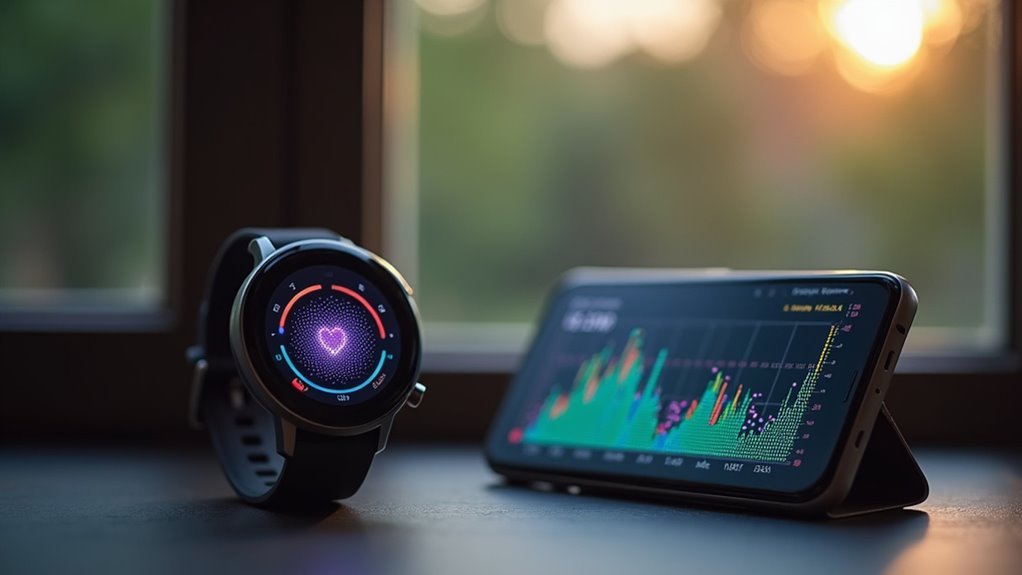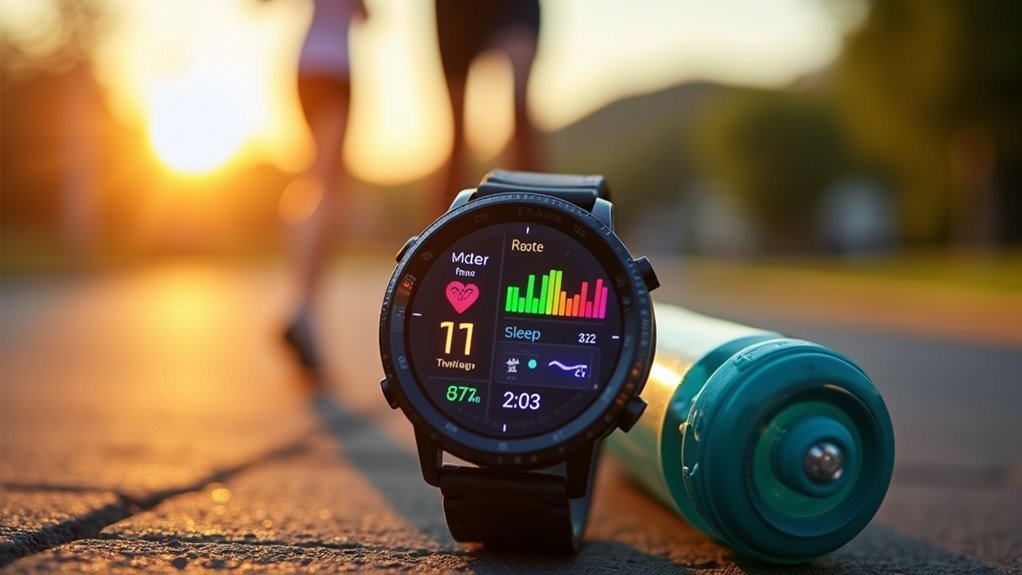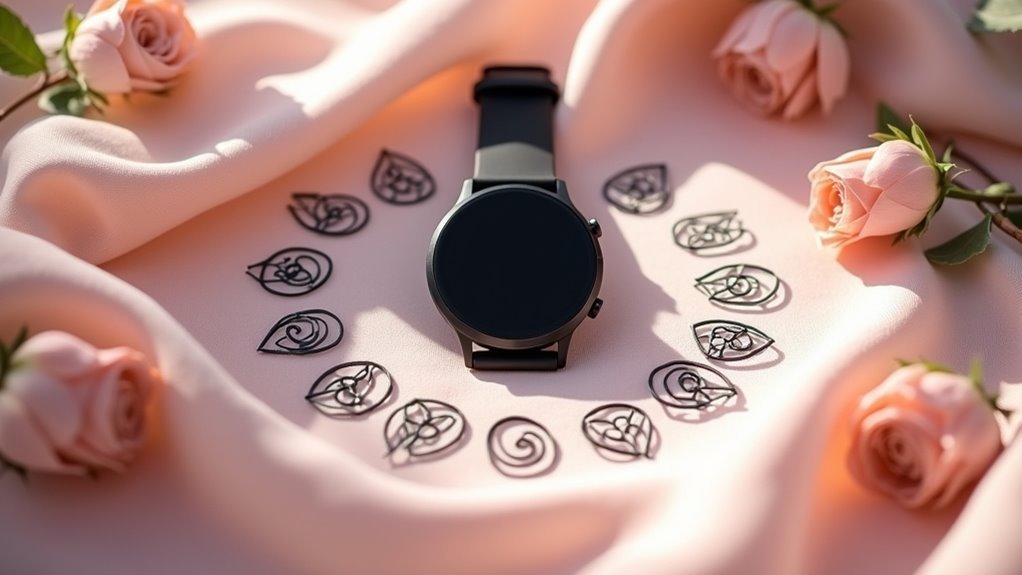Connecting your smartwatch health apps creates a powerful monitoring system that transforms scattered data into extensive health insights. You’ll get real-time tracking of heart rate, sleep patterns, and activity levels while enabling early detection of conditions like atrial fibrillation. This integration provides personalized analytics, seamless healthcare provider communication, and AI-powered predictions that can identify health issues years before symptoms appear. Continue exploring to discover how this connected ecosystem maximizes your health monitoring potential.
Real-Time Health Data Collection Capabilities

Today’s smartwatches pack multiple sensors that continuously track your heart rate, oxygen saturation, sleep quality, and physical activity throughout the day.
These advanced sensors detect even minor physiological changes, dramatically improving the accuracy and relevancy of your health data compared to traditional snapshot measurements.
You’ll benefit from continuous monitoring that creates a thorough picture of your health trends over time.
The integration of biometric and behavioral data gives healthcare providers an in-depth understanding of your wellbeing that extends far beyond clinical visits. Smartwatches can also provide emergency medical assistance by automatically detecting falls and summoning help when needed.
Medical-grade sensors are now being developed specifically to enhance the reliability and clinical usefulness of smartwatch data, making your wearable device an increasingly valuable tool for proactive health management and early intervention strategies.
Proactive Disease Prevention and Early Detection
Your smartwatch isn’t just tracking your steps—it’s actively monitoring your heart’s rhythm and detecting irregular patterns that could signal cardiovascular issues before you even notice symptoms.
The device analyzes your movement patterns throughout the day, identifying subtle changes in your gait or activity levels that might indicate emerging health concerns.
Most importantly, it’s equipped with sophisticated symptom detection capabilities that can recognize early warning signs across multiple health conditions, giving you the opportunity to seek medical attention before problems escalate. Advanced smartwatch algorithms can accurately detect AFib episodes, which significantly reduces your risk of stroke through timely medical intervention.
Heart Disease Monitoring
While heart disease remains the leading cause of death in the United States, smartwatch technology is revolutionizing how you can monitor and prevent cardiovascular problems before they become life-threatening.
Your smartwatch captures essential metrics like heart rate, oxygen saturation, and sleep patterns, enabling early detection of irregular rhythms such as atrial fibrillation. New metrics, including dividing your average daily heart rate by steps taken, provide more reliable indicators of cardiovascular fitness than traditional measurements.
However, only one in four users share this valuable data with healthcare providers. When you connect your smartwatch apps and share integrated health data, you’re giving your doctor a thorough view that supports informed decisions and personalized care plans. A recent survey of over 1,000 U.S. adults found that the majority use various devices for heart health monitoring, with smartwatches leading at 32% usage among respondents.
Movement Pattern Analysis
Beyond detecting irregular heartbeats, smartwatches excel at capturing the subtle movement patterns that can reveal early signs of neurological and musculoskeletal diseases before symptoms become apparent.
Your device’s accelerometer and gyroscope continuously monitor your hand and wrist movements during daily activities, building a detailed profile of your motor function over time.
Machine learning algorithms analyze this data to spot changes that might indicate conditions like Parkinson’s or rheumatoid arthritis developing. You’re contributing to predictive models that’ll help doctors intervene earlier and more effectively.
The recognition of fine-grained movements aids in precise calculations and health screenings, allowing your smartwatch to detect subtle differences in walking patterns and hand motions that traditional monitoring methods might miss.
Here’s what your smartwatch tracks for disease prevention:
- Tremor detection – Identifying involuntary shaking patterns during routine tasks
- Gait analysis – Monitoring walking rhythm and stride consistency
- Fine motor skills – Tracking precision in finger tapping and writing movements
- Daily activity changes – Detecting gradual declines in movement fluidity
Symptom Detection Capabilities
Smartwatches have evolved from simple movement trackers into sophisticated health monitoring systems that can detect illness symptoms before you even feel sick. Your device can identify potential COVID-19 infections by monitoring heart rate and step count changes, flagging issues up to 10 days before symptoms appear.
These algorithms provide yellow or red alerts when they detect concerning patterns in your data.
Your smartwatch shows promise in detecting heart disease through continuous rhythm monitoring and can even identify early Parkinson’s disease symptoms like gait changes years before clinical diagnosis.
While these early warning systems can’t distinguish between infection types, they give you valuable time for medical intervention. This proactive approach improves health outcomes while reducing healthcare costs through prevention rather than treatment. Infected individuals showed an average reduction of 1,440 steps and increased sleep duration, demonstrating how behavioral changes can signal illness onset.
Personalized Health Insights and Analytics
The integration of smartwatch health apps creates a powerful foundation for delivering personalized health insights that go far beyond what traditional healthcare visits can provide.
When you connect multiple health data sources, machine learning algorithms analyze your continuous physiological patterns to detect risks and predict potential health events before they become serious problems.
Your personalized analytics transform raw health data into actionable recommendations tailored specifically to your lifestyle and medical history:
- Predictive heart rhythm alerts that warn you of irregular patterns days before clinical symptoms appear
- Sleep optimization strategies based on your unique circadian rhythm and recovery patterns
- Exercise recommendations calibrated to your fitness level and health goals
- Medication adherence reminders synchronized with your daily activity patterns
This continuous learning system becomes more precise over time, delivering increasingly relevant health guidance. The sophistication of these connected systems is evident in their predictive analytics capabilities, which are driving AI integration in wearables to grow at an impressive 35% annually.
Enhanced Fitness Performance Tracking

While personalized health insights provide the foundation for understanding your body’s patterns, connecting smartwatch health apps elevates your fitness performance tracking to professional-athlete levels of precision.
You’ll monitor extensive metrics including steps, distance, calories burned, and heart rate variability to assess both fitness levels and stress responses. Your apps analyze exercise patterns to suggest ideal workout routines while tracking sleep quality’s impact on performance.
Connected apps provide cadence, pace, distance, and speed monitoring for precise analysis. You’ll enhance recovery periods and receive VO2 max estimates indicating cardiovascular fitness.
Connected fitness apps deliver professional-grade metrics like cadence and VO2 max for data-driven performance optimization.
Integration extends beyond workouts—you’ll monitor stress levels, hydration, body composition, and receive mental health support. Digital rewards like badges and friend competitions boost motivation during challenging training phases. Advanced sensors, AI-powered insights, and social features create a thorough fitness ecosystem that transforms casual exercise into data-driven performance optimization.
Seamless Electronic Health Records Integration
Beyond enhancing your workout metrics, connecting smartwatch health apps to electronic health records creates a seamless bridge between personal fitness data and professional medical care.
This integration transforms your wearable device into a powerful clinical tool that provides healthcare providers with continuous, real-time insights into your health patterns.
When you integrate your smartwatch data with EHRs, you’re creating thorough patient profiles that help doctors make more informed decisions about your care. Health organizations are incorporating UX/UI designers into their IT teams to enhance provider understanding and engagement with wearable patient data.
The secure API connections guarantee your sensitive health information remains protected while enabling interoperability across different healthcare systems.
- Chronic disease monitoring through continuous heart rate and activity tracking
- Early detection alerts when crucial signs indicate potential health concerns
- Remote patient monitoring reducing unnecessary hospital visits
- Personalized treatment plans based on your actual daily health data
Improved Patient Care Coordination

Smartwatch integration with electronic health records enables your entire care team to work with unified, real-time data that transforms how medical professionals coordinate your treatment.
When your smartwatch continuously monitors essential signs, activity levels, and health metrics, it creates a thorough picture that all your healthcare providers can access instantly.
This seamless data sharing means your cardiologist, primary care physician, and specialists see the same accurate information, eliminating communication gaps that could compromise your care.
Real-time monitoring allows providers to intervene promptly when concerning patterns emerge, preventing complications before they escalate.
Your personalized care plans become more effective because they’re built on actual data rather than periodic snapshots. Telemedicine platforms can now incorporate this continuous smartwatch data during virtual consultations, providing doctors with comprehensive insights even when you’re not physically present.
You’ll experience better outcomes through optimized resource allocation, reduced hospitalizations, and healthcare decisions based on your continuous health story.
Customized Workout Plans and Optimization
Your smartwatch doesn’t just count steps—it’s transforming into your personal fitness coach by tracking real-time performance data like heart rate variability, oxygen levels, and recovery metrics.
This continuous stream of biometric information allows fitness apps to create workout plans that adapt specifically to your body’s current state and capabilities.
You’ll receive data-driven recommendations that optimize everything from exercise intensity to rest periods, ensuring each workout maximizes results while minimizing injury risk. The progressive difficulty of these adaptive plans keeps you challenged as your fitness level improves, preventing plateaus and maintaining long-term engagement.
Real-Time Performance Tracking
When you connect your smartwatch to health apps, you access real-time performance tracking that transforms how you approach fitness. Your device monitors heart rate with 70-90% accuracy, providing sufficient data for general fitness tracking and detecting irregular heartbeats.
This integration helps you stay within ideal heart rate zones, improving endurance and fat-burning efficiency. Over 75% utilize heart rate monitoring functionality during their workout activities to maximize training effectiveness.
Real-time tracking offers these powerful benefits:
- Immediate workout adjustments – You’ll modify intensity based on live heart rate feedback during exercise
- Early health alerts – Your watch detects potential atrial fibrillation, prompting medical consultation
- Zone-based training – You’ll maintain target heart rate ranges for maximum workout effectiveness
- Performance optimization – Real-time data helps you push harder or recover when needed
This seamless integration keeps you engaged while maximizing your fitness results.
Personalized Fitness Plans
Machine learning transforms your fitness journey by analyzing your smartwatch data to create workout plans that adapt to your unique profile, goals, and daily reality.
Your app examines historical activity patterns to dynamically adjust exercise intensity, duration, and types based on whether you’re targeting weight loss, endurance, or strength building.
This intelligent system optimizes your workout efficiency by analyzing heart rate zones, calories burned, and recovery times to prevent plateaus and overtraining. With continuous monitoring providing real-time cardiovascular data, your smartwatch can alert you to irregular heart rhythms during workouts.
It integrates nutrition, sleep, and stress data to recommend rest days when you need them most, ensuring sustainable progress.
You’ll stay motivated because your plan accommodates fluctuating energy levels and time constraints while celebrating personalized milestones that reflect your actual progress rather than generic benchmarks.
Data-Driven Workout Decisions
The convergence of multiple health data streams transforms your smartwatch into an intelligent workout coach that makes split-second decisions about your exercise routine.
Your device analyzes heart rate variability, sleep quality, and stress markers to recommend whether you should push harder or ease back during today’s session. This real-time feedback prevents overtraining while maximizing performance gains.
Data-driven decisions create vivid workout scenarios:
- Storm brewing outside – Your apps automatically suggest an indoor HIIT session instead of your planned outdoor run.
- Elevated resting heart rate detected – System recommends gentle yoga over intense cardio.
- Poor sleep quality registered – Workout intensity drops by 20% to prevent burnout.
- Stress levels spiking – Apps pivot to meditation-focused movement sessions.
You’ll experience personalized adjustments that adapt to your body’s daily fluctuations. With 320 million people using health apps, this data-driven approach to workout optimization has become increasingly sophisticated and accessible.
Heart Disease and Movement Disorder Monitoring
As heart disease remains the leading cause of death in the United States, smartwatches have emerged as powerful tools for early detection and continuous monitoring of cardiovascular health. Your smartwatch captures essential metrics like heart rate, oxygen saturation, and fitness levels, creating a thorough cardiovascular profile.
These devices can detect irregular rhythms such as atrial fibrillation earlier than traditional methods, potentially saving your life through timely intervention. Researchers have developed a new metric that divides your average daily heart rate by steps taken to better assess cardiovascular fitness than traditional exercise quantity measurements.
However, you’ll face challenges with movement disorder monitoring due to device limitations and data interpretation complexities. Only one in four users share their health data with healthcare providers, limiting monitoring effectiveness.
Only one in four smartwatch users shares health data with doctors, creating gaps in effective cardiovascular monitoring.
While smartwatches excel at heart rate tracking, they may miss subtle movement disorder nuances without additional sensors. Regular usage compliance also affects data continuity.
Direct Communication With Healthcare Providers
While traditional healthcare appointments limit communication to scheduled visits, smartwatch health apps now enable continuous dialogue between you and your healthcare providers through real-time data sharing.
This direct communication transforms your care experience by providing detailed health metrics that inform medical decisions. You’re no longer restricted to describing symptoms from memory—your provider receives extensive data showing patterns, trends, and anomalies in your essential signs.
Despite widespread willingness among users to share their wearable data with healthcare providers, a significant implementation gap exists between intention and actual data sharing practices.
The benefits you’ll experience include:
- Personalized treatment plans tailored to your specific health patterns and daily activities
- Early intervention alerts when concerning trends emerge in your continuous monitoring data
- Reduced appointment frequency through effective remote monitoring of chronic conditions
- Enhanced care coordination with integrated data flowing seamlessly into your electronic health records
AI-Powered Health Predictions and Recommendations
Your smartwatch’s AI doesn’t just collect health data—it transforms that information into actionable predictions about your future well-being.
Through predictive analytics, you’ll receive personalized treatment recommendations tailored specifically to your unique health patterns and risk factors. AI algorithms can analyze your continuous data streams to detect anomalies and predict potential complications, including forecasting hyperglycemic events for diabetic patients and identifying early signs of cardiac irregularities.
This proactive approach lets you address potential health issues before they become serious problems, shifting from reactive healthcare to preventive wellness management.
Predictive Analytics Enhanced Accuracy
Modern smartwatches equipped with AI-powered predictive analytics can identify potential health risks days or weeks before you’d notice any symptoms.
These sophisticated algorithms analyze continuous streams of your physiological data, learning from patterns in heart rate variability, sleep quality, and activity levels to flag subtle abnormalities that traditional monitoring might miss.
Machine learning models enhance accuracy by cross-referencing multiple health signals simultaneously, reducing both false positives and missed detections. Healthcare providers gain access to comprehensive patient-generated health data that enables more informed clinical decisions and timely interventions.
Your smartwatch’s AI continuously refines its predictions as it collects more personalized data.
- Heart rhythm irregularities detected through subtle rate pattern changes during rest
- Sleep disorder indicators identified via breathing and movement analysis
- Infection onset markers spotted through temperature and activity fluctuations
- Overtraining symptoms recognized before fatigue becomes overwhelming
Personalized Treatment Recommendations
Once your smartwatch’s AI algorithms have detected potential health risks, they transform this predictive intelligence into actionable, personalized treatment recommendations tailored specifically to your unique physiological profile. Data integration from various health apps creates a thorough picture that enables customized feedback for exercise, nutrition, and lifestyle modifications.
| Health Metric | Personalized Recommendation |
|---|---|
| Irregular heart rate | Adjusted cardio intensity levels |
| Poor sleep quality | Optimized bedtime routines |
| High stress patterns | Targeted meditation schedules |
| Low activity levels | Customized movement reminders |
Your smartwatch continuously monitors specific conditions, providing real-time data that adjusts treatment plans dynamically. This ongoing data collection guarantees recommendations improve over time, while condition monitoring offers immediate insights that help you make informed health decisions throughout your day. The mHealth apps market is projected to reach $111.1 billion by 2025, demonstrating the significant growth in personalized health technology solutions.
Proactive Risk Assessment
While traditional healthcare relies on reactive treatment after symptoms appear, AI-powered smartwatch health apps shift the paradigm toward proactive risk assessment by analyzing your biometric data to predict potential health issues before they develop into serious conditions.
Machine learning algorithms continuously process your heart rate, sleep patterns, body temperature, and activity levels to identify subtle changes that indicate emerging health risks. These predictive models can detect cardiovascular or neurological disorders years before symptoms manifest, triggering personalized alerts when anomalies occur. Advanced sensor technology and miniaturization have enabled these sophisticated wearables to monitor diverse health parameters with unprecedented accuracy.
Your connected health ecosystem creates dynamic risk profiles that:
- Monitor your essential signs 24/7 for early warning patterns
- Alert healthcare providers instantly when critical thresholds are detected
- Adapt predictions continuously as new data flows in
- Reduce healthcare costs through preventive interventions rather than emergency treatments
Comprehensive Health Data Centralization
As healthcare becomes increasingly digitized, connecting your smartwatch health apps creates a powerful centralized hub that consolidates diverse metrics like heart rate, blood oxygen levels, and activity data into a single repository.
This integration eliminates data fragmentation that occurs when health parameters remain isolated across separate platforms.
You’ll gain access to holistic health profiling that combines multiple sensor readings, providing a complete picture of your wellness status. The aggregated information helps detect correlations between different health indicators, enhancing diagnostic accuracy and enabling healthcare providers to make better-informed decisions about your care.
Centralized data also facilitates continuous monitoring over time, capturing important trends and generating early warning signals that might indicate health deterioration before symptoms become apparent. This comprehensive tracking enables early intervention strategies that can significantly reduce the risk of hospitalization and improve overall health outcomes.
Enhanced User Engagement and Retention
Two-thirds of smartwatch health app users struggle with consistent daily engagement, making retention a critical factor in maximizing your health monitoring benefits.
Connected health apps dramatically improve your long-term usage by creating thorough feedback loops that motivate continued participation.
Health apps with integrated feedback systems create sustainable engagement patterns that transform sporadic tracking into meaningful long-term health monitoring habits.
Integrated systems boost your engagement through:
- Consolidated progress tracking – You’ll see complete health patterns across multiple apps, creating stronger motivation to maintain habits.
- Simplified daily workflows – One dashboard eliminates app-switching fatigue that causes 75% of users to abandon health tracking.
- Enhanced feedback quality – Combined data generates more meaningful insights, increasing your satisfaction scores above the 80% threshold.
- Reduced complexity barriers – Streamlined interfaces keep task completion under two minutes, maintaining the 25%+ retention rate that indicates true user satisfaction.
The fitness app industry’s explosive growth demonstrates this trend, with revenues projected to reach $33.04 billion by 2027 as more users discover the benefits of connected health ecosystems.
Future Wearable Technology Innovations
Beyond today’s basic fitness tracking, tomorrow’s wearable technology will revolutionize how you monitor and manage your health through artificial intelligence integration.
You’ll experience personalized wellness recommendations generated from continuous biometric monitoring, while conversational virtual assistants provide real-time health coaching directly on your wrist.
Your smartwatch will transform into a thorough health coach, offering tailored fitness plans with adaptive feedback loops. Advanced sensors will deliver precise EKG readings, blood oxygen levels, and stress indicators.
You’ll benefit from cutting-edge materials enabling smart contact lenses for glucose monitoring and e-tattoos providing unobtrusive skin-level tracking.
AI-powered predictive analytics will convert raw sensor data into actionable insights, allowing early identification of health risks and seamless integration with cloud ecosystems for complete wellness management. Leading brands like Apple, Samsung, and Garmin are positioning themselves at the forefront of this wearable revolution.
Frequently Asked Questions
What Happens to My Health Data if I Switch Smartwatch Brands?
You’ll likely lose your historical health data when switching smartwatch brands because manufacturers use closed ecosystems with incompatible data formats, forcing you to start fresh data collection.
How Much Does Connecting Multiple Health Apps Typically Cost Monthly?
You’ll typically pay $29-$500 monthly for health app integration services, depending on features and users. Basic consumer health apps often cost $75+ per appointment, while extensive healthcare communication platforms require higher monthly subscriptions.
Can Employers Access My Smartwatch Health Data Through Workplace Wellness Programs?
Employers can access your smartwatch health data if you’re enrolled in workplace wellness programs, but they must follow strict ADA privacy rules and keep medical information confidential from employment decisions.
What Happens if My Smartwatch Malfunctions During Critical Health Monitoring?
Your smartwatch malfunction during critical monitoring could delay life-saving medical interventions, compromise data accuracy, and miss dangerous health changes. You’d face gaps in monitoring that might worsen outcomes and delay emergency care.
Are There Age Restrictions for Children Using Connected Smartwatch Health Apps?
You’ll find most children’s smartwatch health apps don’t specify strict age restrictions, though devices like JrTrack target ages 6-12. Your child’s maturity matters more than age, but you should maintain parental oversight.
In Summary
You’ll transform your health management by connecting smartwatch health apps together. You’re gaining real-time insights, early disease detection, and personalized analytics that’ll help you make better health decisions. You’ll track fitness performance more effectively while seamlessly integrating data with your healthcare providers. With AI-powered predictions and centralized health information, you’re positioning yourself for proactive wellness management. You’re not just wearing technology—you’re creating an extensive health ecosystem that’ll evolve with future innovations.





Leave a Reply